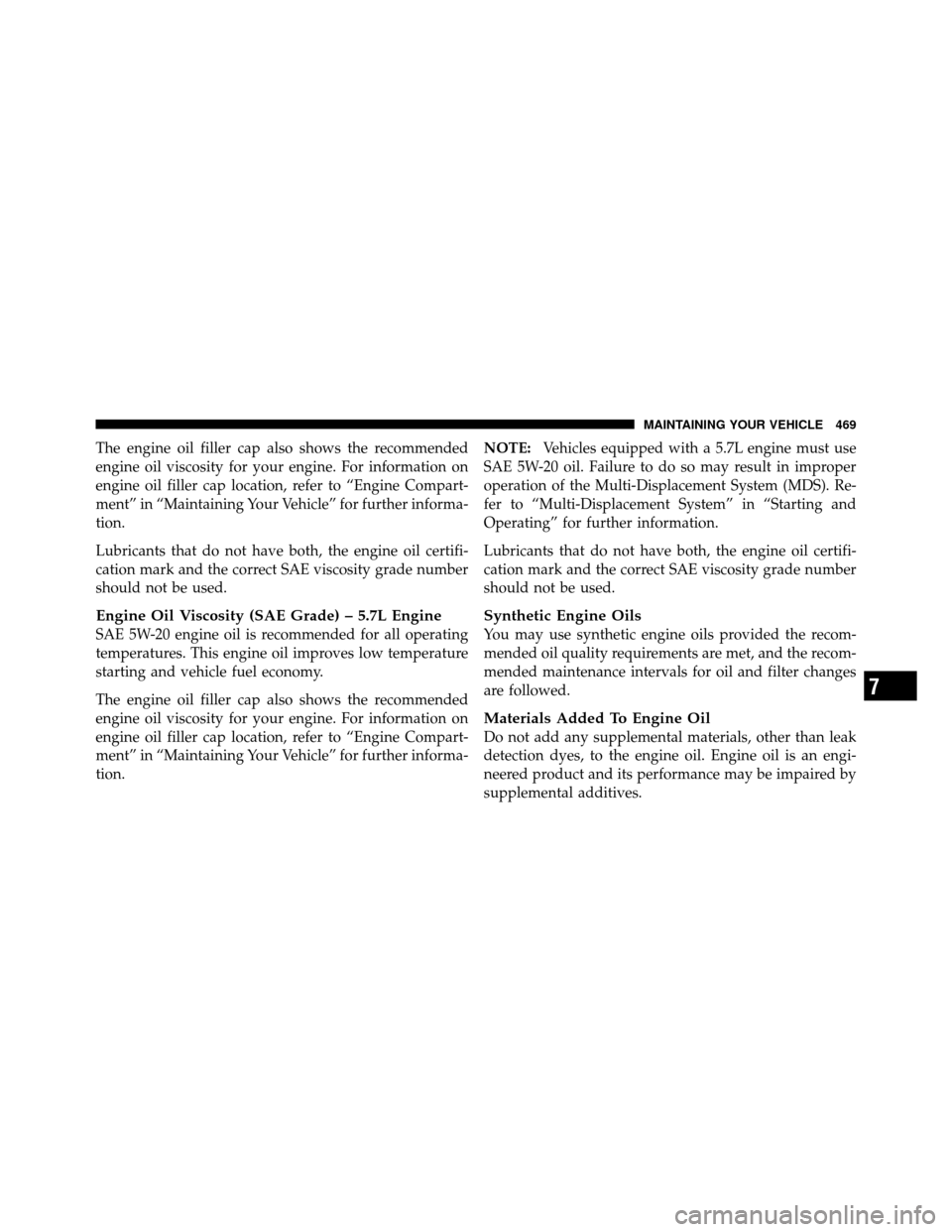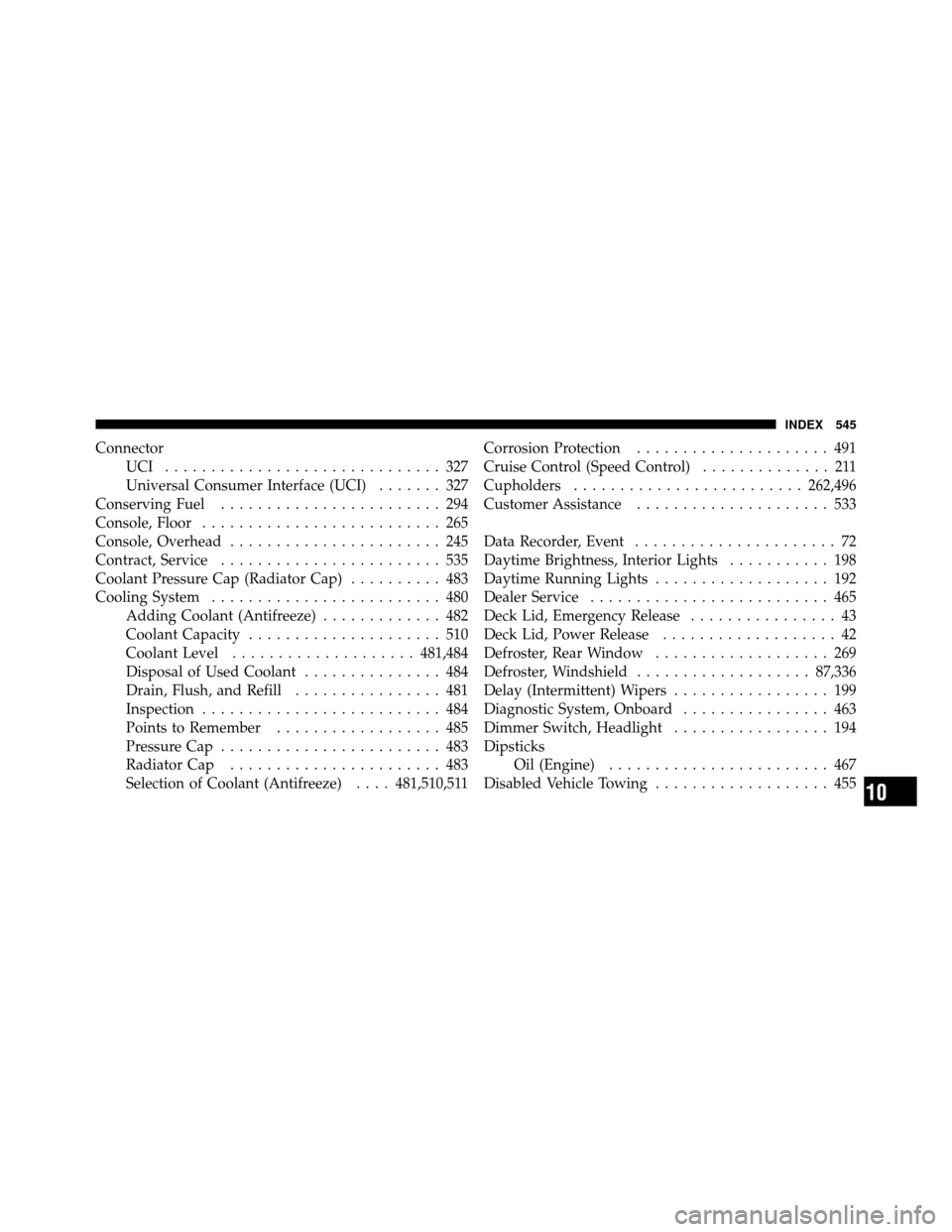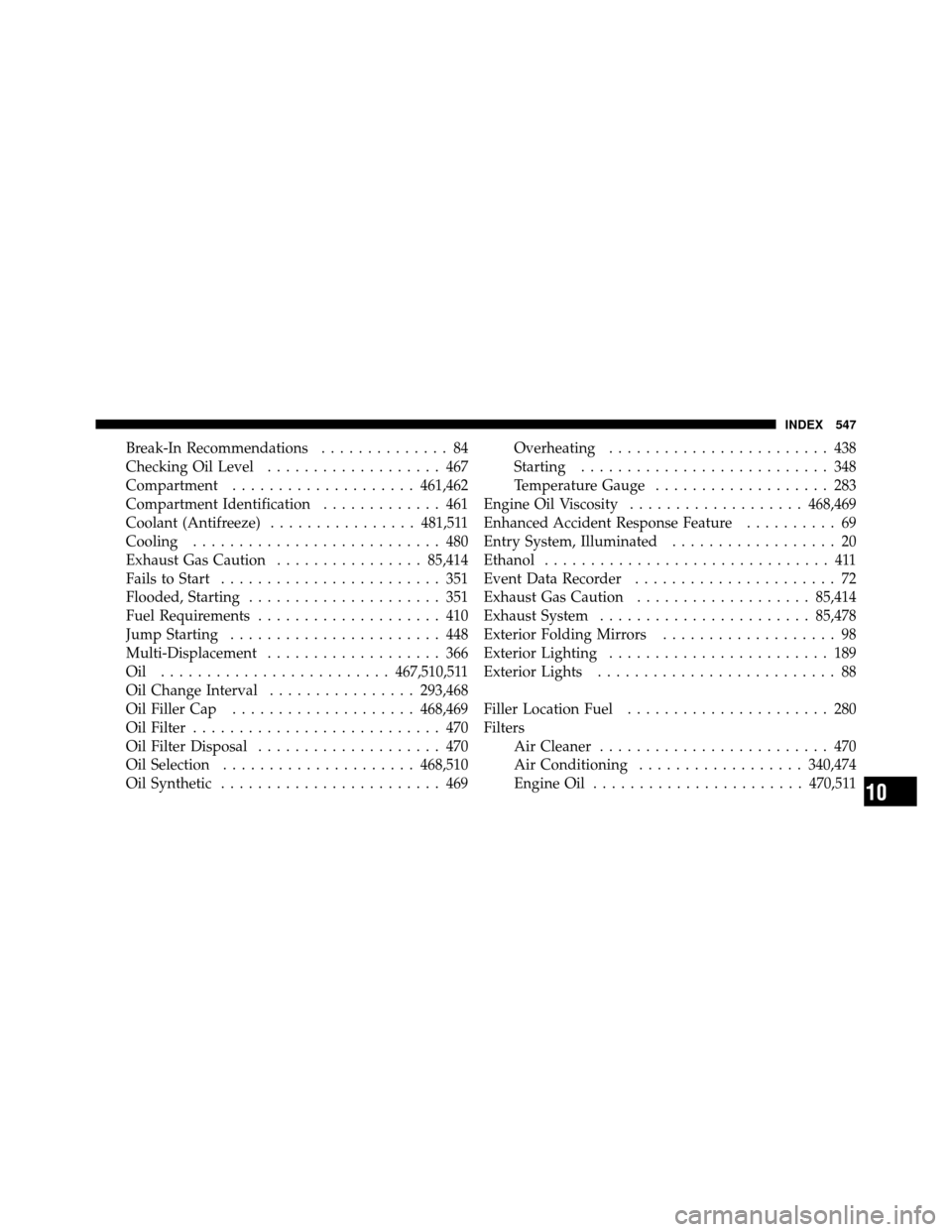Page 404 of 566

CAUTION!
•The TPMS has been optimized for the original
equipment tires and wheels. TPMS pressures and
warning have been established for the tire size
equipped on your vehicle. Undesirable system
operation or sensor damage may result when us-
ing replacement equipment that is not of the same
size, type, and/or style. Aftermarket wheels can
cause sensor damage. Do not use aftermarket tire
sealants or balance beads if your vehicle is
equipped with a TPMS, as damage to the sensors
may result.
•After inspecting or adjusting the tire pressure,
always reinstall the valve stem cap. This will
prevent moisture and dirt from entering the valve
stem, which could damage the TPM sensor.NOTE:
•The TPMS is not intended to replace normal tire care
and maintenance or to provide warning of a tire failure
or condition.
•The TPMS should not be used as a tire pressure gauge
while adjusting your tire pressure.
•Driving on a significantly under-inflated tire causes
the tire to overheat and can lead to tire failure.
Under-inflation also reduces fuel efficiency and tire
tread life, and may affect the vehicle’s handling and
stopping ability.
•The TPMS is not a substitute for proper tire mainte-
nance, and it is the driver ’s responsibility to maintain
correct tire pressure using an accurate tire pressure
gauge, even if under-inflation has not reached the
level to trigger illumination of the TPM Telltale Light.
402 STARTING AND OPERATING
Page 421 of 566
3. There is no fuel filler cap. A flapper door inside the
pipe seals the system.4. Insert the fuel nozzle fully into the filler pipe – the
nozzle opens and holds the flapper door while refueling.
NOTE:
Only the correct size nozzle opens the latches
allowing the flapper door to open.
5. Fill the vehicle with fuel – when the fuel nozzle
“clicks” or shuts off the fuel tank is full.
6. Remove the fuel nozzle and close the fuel door.
Fuel Filler Door
5
STARTING AND OPERATING 419
Page 423 of 566
Emergency Fuel Filler Door Release
If you are unable to open the fuel filler door, use the fuel
filler door emergency release.
1. Open the trunk.
2. Remove the access cover (located on the left side inner
trim panel).3. Pull the release cable.
VEHICLE LOADING
The load carrying capacity of your vehicle is shown on
the “Vehicle Certification Label.” This information
should be used for passenger and luggage loading as
indicated.
Access Cover
Release Cable
5
STARTING AND OPERATING 421
Page 471 of 566

The engine oil filler cap also shows the recommended
engine oil viscosity for your engine. For information on
engine oil filler cap location, refer to “Engine Compart-
ment” in “Maintaining Your Vehicle” for further informa-
tion.
Lubricants that do not have both, the engine oil certifi-
cation mark and the correct SAE viscosity grade number
should not be used.
Engine Oil Viscosity (SAE Grade) – 5.7L Engine
SAE 5W-20 engine oil is recommended for all operating
temperatures. This engine oil improves low temperature
starting and vehicle fuel economy.
The engine oil filler cap also shows the recommended
engine oil viscosity for your engine. For information on
engine oil filler cap location, refer to “Engine Compart-
ment” in “Maintaining Your Vehicle” for further informa-
tion.NOTE:
Vehicles equipped with a 5.7L engine must use
SAE 5W-20 oil. Failure to do so may result in improper
operation of the Multi-Displacement System (MDS). Re-
fer to “Multi-Displacement System” in “Starting and
Operating” for further information.
Lubricants that do not have both, the engine oil certifi-
cation mark and the correct SAE viscosity grade number
should not be used.
Synthetic Engine Oils
You may use synthetic engine oils provided the recom-
mended oil quality requirements are met, and the recom-
mended maintenance intervals for oil and filter changes
are followed.
Materials Added To Engine Oil
Do not add any supplemental materials, other than leak
detection dyes, to the engine oil. Engine oil is an engi-
neered product and its performance may be impaired by
supplemental additives.
7
MAINTAINING YOUR VEHICLE 469
Page 512 of 566
FLUID CAPACITIES
U.S.Metric
Fuel (Approximate)
All Engines 19 Gallons72 Liters
Engine Oil with Filter
3.6 Liter Engine (SAE 5W-30, API Certified) 6 Quarts5.6 Liters
5.7 Liter Engine (SAE 5W-20, API Certified) 7 Quarts6.6 Liters
Cooling System *
3.6 Liter Engine (MOPAR� Antifreeze/Coolant 5 Year/100,000 Mile
Formula or equivalent) 10 Quarts
9.5 Liters
5.7 Liter Engine without Severe Duty II Cooling System (MOPAR�
Antifreeze/Coolant 5 Year/100,000 Mile Formula or equivalent) 14.5 Quarts 13.9 Liters
5.7 Liter Engine with Severe Duty II Cooling System (MOPAR�
Antifreeze/Coolant 5 Year/100,000 Mile Formula or equivalent) 15 Quarts
14.3 Liters
* Includes heater and coolant recovery bottle filled to MAX level.
510 MAINTAINING YOUR VEHICLE
Page 513 of 566
FLUIDS, LUBRICANTS, AND GENUINE PARTS
Engine
ComponentFluid, Lubricant, or Genuine Part
Engine Coolant MOPAR�Antifreeze/Coolant 5 Year/100,000 Mile Formula HOAT (Hy-
brid Organic Additive Technology) or equivalent.
Engine Oil – 3.6L Engine Use API Certified SAE 5W-30 Engine Oil, meeting the requirements of
Chrysler Material Standard MS-6395. Refer to the engine oil fill cap for
correct SAE grade.
Engine Oil – 5.7L Engine Use API Certified SAE 5W-20 Engine Oil, meeting the requirements of
Chrysler Material Standard MS-6395. Refer to the engine oil fill cap for
correct SAE grade.
Engine Oil Filter MOPAR�Engine Oil Filter or equivalent.
Spark Plugs – 3.6L Engine RER8ZWYCB4 (Gap 0.043 in [1.1 mm])
Spark Plugs – 5.7L Engine LZFR5C–11 (Gap 0.043 in [1.1 mm])
Fuel Selection – 3.6L Engine 87 Octane
Fuel Selection – 5.7L Engine 87 Octane Acceptable – 89 Octane Recommended
7
MAINTAINING YOUR VEHICLE 511
Page 547 of 566

ConnectorUCI .............................. 327
Universal Consumer Interface (UCI) ....... 327
Conserving Fuel ........................ 294
Console, Floor .......................... 265
Console, Overhead ....................... 245
Contract, Service ........................ 535
Coolant Pressure Cap (Radiator Cap) .......... 483
Cooling System ......................... 480
Adding Coolant (Antifreeze) ............. 482
Coolant Capacity ..................... 510
Coolant Level .................... 481,484
Disposal of Used Coolant ............... 484
Drain, Flush, and Refill ................ 481
Inspection .......................... 484
Points to Remember .................. 485
Pressure Cap ........................ 483
Radiator Cap ....................... 483
Selection of Coolant (Antifreeze) ....481,510,511 Corrosion Protection
..................... 491
Cruise Control (Speed Control) .............. 211
Cupholders ......................... 262,496
Customer Assistance ..................... 533
Data Recorder, Event ...................... 72
Daytime Brightness, Interior Lights ........... 198
Daytime Running Lights ................... 192
Dealer Service .......................... 465
Deck Lid, Emergency Release ................ 43
Deck Lid, Power Release ................... 42
Defroster, Rear Window ................... 269
Defroster, Windshield ................... 87,336
Delay (Intermittent) Wipers ................. 199
Diagnostic System, Onboard ................ 463
Dimmer Switch, Headlight ................. 194
Dipsticks Oil (Engine) ........................ 467
Disabled Vehicle Towing ................... 455
10
INDEX 545
Page 549 of 566

Break-In Recommendations.............. 84
Checking Oil Level ................... 467
Compartment .................... 461,462
Compartment Identification ............. 461
Coolant (Antifreeze) ................ 481,511
Cooling ........................... 480
Exhaust Gas Caution ................85,414
Fails to Start ........................ 351
Flooded, Starting ..................... 351
Fuel Requirements .................... 410
Jump Starting ....................... 448
Multi-Displacement ................... 366
Oil ......................... 467,510,511
Oil Change Interval ................ 293,468
Oil Filler Cap .................... 468,469
Oil Filter ........................... 470
Oil Filter Disposal .................... 470
Oil Selection ..................... 468,510
Oil Synthetic ........................ 469 Overheating
........................ 438
Starting ........................... 348
Temperature Gauge ................... 283
Engine Oil Viscosity ................... 468,469
Enhanced Accident Response Feature .......... 69
Entry System, Illuminated .................. 20
Ethanol ............................... 411
Event Data Recorder ...................... 72
Exhaust Gas Caution ................... 85,414
Exhaust System ....................... 85,478
Exterior Folding Mirrors ................... 98
Exterior Lighting ........................ 189
Exterior Lights .......................... 88
Filler Location Fuel ...................... 280
Filters Air Cleaner ......................... 470
Air Conditioning .................. 340,474
Engine Oil ....................... 470,511
10
INDEX 547